Combat Flight Simulator 3 Preview
We go hands-on with the next game in Microsoft's Combat Flight Simulator series.
Slowly but surely, Microsoft is getting it right. Successive forays into the combat side of flight simulators have produced solid products with great expandability and solid simulation credentials. After a trip to the Pacific in Combat Flight Simulator 2, the series is returning to the skies of Europe in the third installment. Europe is almost a default location for this kind of game, and Combat Flight Simulator 3 is actually not even the first European air war sim in the series, since this WWII theater of operations was modeled in the very first Combat Flight Simulator in 1998. Still, it's amazing to see how Europe has changed in four years.
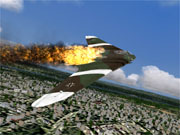
We've played a fairly complete version of Combat Flight Simulator 3, with most of its core features (like flight models and graphics) complete or almost so. The campaign wasn't quite done, and the game is being constantly revised, so the issues discussed here may be addressed before the final version is released. Still, what we saw looks like an improvement on the previous Combat Flight Simulator in many respects, and it has the potential to set a new standard in European theater flight sims.
Terrain graphics are the Achilles' heel of flight sims. Almost anything can be made to look good from 20,000 feet, but the hard part is making "down low" graphics that look good and don't cripple your frame rate. The preview material makes a big deal out of CFS3's "low-altitude air combat," which is almost certainly meant to draw attention to the new graphics engine featured in the game. The CFS3 graphics engine maintains high resolution down to 120 meters, allowing for high detail even when flying at treetop level. Some of the graphics are quite well done, while some of the snow and other inclement weather textures are a bit less so. The game does a nice job of automatically generating terrain features as you fly down low so the terrain looks random and even reacts to your actions if you, for example, fly too far out of your way and stray over an enemy airfield that wasn't part of your original mission.
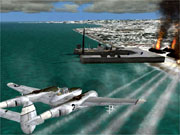
One of the really outstanding aspects of the new graphics engine is the way it handles clouds, which look incredible and truly "volumetric," as advertised. Having realistic clouds not only makes the game look great, but it also opens up several interesting combat tactics, as you can duck into cloud cover to shake an attacker or hide in or behind cloud banks to ambush unsuspecting enemies. The fog and weather effects aren't quite up to this standard, but in general the graphics are several leaps ahead of any other European-theater flight sim, and as with the previous game, the aircraft models and textures are top-notch. The cockpits are as good as in the previous game, and the HUD is even customizable (you can drag the instruments to various locations on your screen) for those who value convenience over historical accuracy.
Combat Flight Simulator releases traditionally haven't had many flyable aircraft. CFS3 addresses this issue by including 18 base aircraft types, with enough variants to bring the final count to 34 flyable aircraft. Each country (Germany, USA, Great Britain) has six basic types. All the standard European air war models are included, such as the Me-109, the Focke-Wulf 190, the Me-262, the Spitfire, the P-38 Lightning, the P-47 Thunderbolt, and the P-51 Mustang. There are quite a few unusual aircraft as well, including the British de Havilland Vampire (Britain's second and more unusual-looking jet), the American P-80 Shooting Star and Curtiss P-55 Ascender (the latter of which was abandoned before it reached production), and the German Dornier Do-335 turboprop and Gotha Go-229 flying wing (also known as the Horten Ho-IX). None of these exotic aircraft actually saw combat in World War II, but you can fly them in the game.
Into the Wild Blue Yonder
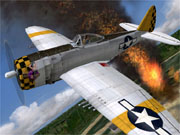
In keeping with the low-altitude air combat theme, each country also has a medium bomber included (the B-26 Marauder for the US, the Ju-88 for Germany, and the American-built B-25 Mitchell for Great Britain). Because of the emphasis on ground attacks, we assume, there are also several ground-attack modifications of the Ju-88 included (including the C and P models). Additionally, you'll have the opportunity to fly plenty of missions in fighter-bombers like the Hawker Typhoon and the Tempest. Since there won't be any B-17s in the game, there won't be any high-altitude interception missions for German players.
Commenting on flight models is a tricky business, as relatively small differences in performance can have large play-balance effects. We weren't able to comprehensively test each aircraft in combat, but the characteristic features of each aircraft's performance (the sustained high-speed maneuverability of the Mustang, the nimbleness and acceleration of the Spitfire) appear realistic, and if you're played lots of World War II combat simulations, you'll probably find that the planes "feel" right. One issue that seems to carry over from Combat Flight Simulator 2 is the uncanny accuracy of AI bomber gunners. Approaching a flight of Mitchells in your Me-109 is a dangerous undertaking, perhaps so much so that the actual effectiveness of gunners in these positions is misrepresented. These are things that can be easily tweaked before the game goes final, though, so hopefully these issues will be addressed.
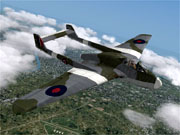
The ability to fly bombers is new to the Combat Flight Simulator series, and it was sorely missed in the previous iteration, as it would have been nice to fly dive-bombers and torpedo-bombers in the Pacific. Combat Flight Simulator 3 won't let you fly the heavy bombers like the Flying Fortress or the Lancaster, but it will let you pilot the medium bombers and man their gunners' stations. You can easily cycle through the gunnery positions and back into the cockpit, but this is a prime candidate for cooperative multiplayer, which the game will fully support. Some of the gunnery in this build was problematic, with one Ju-88 gunner's station producing a muzzle flash several virtual feet to the right of the machine gun.
Longevity in flight sims is most often achieved in one of two ways: an engaging an replayable dynamic campaign, or lots of cooperative multiplayer missions. (The best solution is an engaging and replayable dynamic campaign that fully supports multiplayer, but that's a tall order.) Combat Flight Simulator 2 featured a branching, albeit scripted, campaign that gave a feeling of predictability to something as unpredictable as the carrier war. Combat Flight Simulator 3 incorporates a more continuous, "dynamic" campaign in which you can see your mission options in the context of the battlefield as it stands at that moment. The theater map is divided up into a grid of individual sectors. These sectors are quite small, which leads to a lot of variation from game to game as the campaign progresses. You won't see the AI flying its own missions like in Battle of Britain, but you will get a sense of the vastness of the conflict.
Death From Above
The campaign starts out in 1943, and as a rookie pilot, you don't have much choice as to your initial missions. The game designates a "front line" (which, before the D-Day invasion, is basically the English Channel), and you can choose which sector of the front line to engage. This choice will determine the mission types you can fly, so, for example, missions flown over the Channel will be anti-shipping. There are also designated "invasion zones" that can be the basis for a nonhistorical Operation Overlord, and you can "soften up" these zones with ground-attack missions. Success in these missions increases the chance that the invasion zone you concentrate on is the one chosen for the actual invasion, and in this way you can influence the direction of the war. As you earn prestige points for successfully completing missions, you can launch a ground offensive in a particular sector, influencing the direction of the war even further. You'll also gain better health, vision, and G-force tolerance as you earn points and spend them on these areas, which adds a bit of a role-playing element to the game.
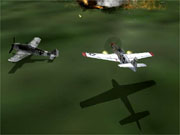
All this, of course, involves some serious sacrifices in realism, as there is no realistic way that a pilot, even Nazi uber-ace Adolf Galland, could single-handedly make as operational contribution so significant as to change the course of the war. This is a problem facing any truly dynamic campaign--unless you're carrying a nuclear weapon, your chance of actually changing the war is about zero. Combat Flight Simulator 3 does a nice job of slowly expanding your range of possibilities without either locking you onto rail or letting you move armies around single-handedly on the campaign map. The game strikes a nice balance in that by the time you start being able to make a significant contribution to the war effort, you'll have flown so many missions that you'll feel you damn well deserve it.
Multiplayer features were another weakness in Combat Flight Simulator 2. With this game, Microsoft is finally adding cooperative missions, which is a must for any serious flight sim these days. Unfortunately, the "persistent, online campaigns" that were originally planned to be included in the game will no longer make the final build. This feature would have integrated the dynamic campaign engine into the multiplayer component, and would have given this product great longevity, especially with the variety of results that could have been generated by the campaign as it works right now.
One of the biggest selling points of the Combat Flight Simulator series is its expandability, both in terms of new aircraft and new scenery. According to Microsoft, "Combat Flight Simulator 3: Battle for Europe is not backward-compatible with previous versions--the important changes to the CFS3 engine mean it can only use scenery, aircraft, and missions that have been created using new methods." However, a 3D modeling tool will ship with CFS3, and further software development kits will follow. There will inevitably be the host of add-on products for this game, like with all Combat Flight Simulator games, so hopefully the lack of backward-compatibility won't hamper people's ability to do the things that count, like import F6F Hellcats and fly them over Berlin.
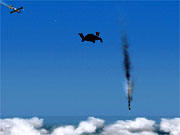
Each subsequent version of Combat Flight Simulator seems to fix a few problems and make major advances in some area. Combat Flight Simulator 2 made a huge leap in aircraft graphics and cleaned up some other problems (like the 3D cockpit art), and Combat Flight Simulator 3 is taking on terrain graphics and trying to fix the other glaring flaws in its predecessor (the campaign and the multiplayer features). With the beta this far along, it looks like CFS3 is shaping up to be an interesting product. If all the issues are addressed, this game has the potential to be a lot more than just another European flight sim.
Got a news tip or want to contact us directly? Email news@gamespot.com
Join the conversation